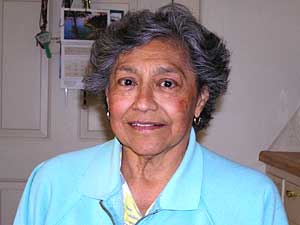 |
| Josephine Ruiz, 73, has severe arthritis which is especially painful in cold weather. But she has a limited income, so she turns the heat in her house way down in the winter to save money on her heating bills. (MPR Photo/Lorna Benson ) |
West St. Paul, Minn. — Every winter, Josephine Ruiz tries to save money by using as little heat as possible.
"I dress warm and I keep that thermostat way down. Sometimes I turn it off and just use my little space heater," says Ruiz. "And then I close off the registers where the heat comes out."
Ruiz knows it's risky to shut off her heat -- her water pipes could burst, although so far they haven't. She says that's because she's been careful not to shut off the heat when it's too far below freezing.
Still, her West St. Paul house gets really cold. In previous winters she would escape to a warm department store for a few hours, or get in her daughter's car and turn on the heat for a few minutes.
To stay warm at night, Ruiz piles lots of blankets on her bed.
"These are all my stash here. One, two, three, four, five and I've got two upstairs," she says during a tour of her home.
When the blankets are not enough, she calls on her closest companion.
"I have my dog," says Ruiz. "Cuddles up. Little bed that I have, she comes up and she cuddles real good. Keeps me nice and warm."
Ruiz has severe arthritis, so the mornings are tough for her.
"It's heck getting up in that cold, cold thing. Oh, it's just horrible. My 'arther' (arthritis) won't leave me alone then," says Ruiz. "With arthritis, you have to keep it really warm. So that's how I can tell when I'm having it too cold, because I start feeling it in my body."
Josephine Ruiz is 73. Her youthful face belies her age, but her hunched back doesn't. Her arthritis is the result of a fall from a ladder many years ago. Because of that injury she gets disability payments.
With disability, retirement and food stamps, Ruiz receives about $800 a month. Her rent is $575 a month. There's very little money left over to pay her heating bill.
Ruiz qualifies for heating assistance and receives the maximum subsidy. Approximately 60 percent of her heating bill is paid through federal grants.
Even with that help, she's already $100 behind on her bill going into this heating season. And the stress of that weighs on her.
|
I wish winter would never come right now, the way I feel with the heating going up. I don't know what I'm going to do.
- Josephine Ruiz
|
"You think oh, I'm grateful for what I'm getting, but I sure could use some more. Yep, to hold me over," Ruiz says as she chokes back tears.
Ruiz isn't the only one who's worried. More Minnesotans than ever are applying for heating assistance this year.
Catherine Fair, the energy assistance manager for the Community Action Partnership of Ramsey and Washington counties, says so far her office has received more than 6,000 applications for heating assistance, a record this early in the season.
"Our office is busy all day long with people walking in, either just to apply or needing emergency help with their bills," Fair says.
Fair says energy assistance grants are expected to increase from an average of $400 last winter to about $500 this winter. But she says if natural gas heating prices go up more than 50 percent, as they're expected to, energy assistance grants can't cover the difference.
"That is still substantially more money out of pocket for low income people," says Fair. "So that's where these decisions are going to be made about heating or eating."
Fair says she is hopeful all the attention surrounding natural gas prices will result in a big boost in federal heating assistance. Congress is being urged to increase funding to $4 billion, compared to the $2.5 billion allocated last year. But lawmakers haven't told states yet what they'll receive.
Even if more money is added to the heating assistance pool, it might not increase the size of individual grants if more people qualify for the program.
In the meantime, Josephine Ruiz continues to do what she can to keep her heating costs down.
"I wish winter would never come right now the way I feel, with the heating going up," says Ruiz. "I'm hesitant on facing the winters now. I'm really hesitant. And I don't know what I'm going to do."






